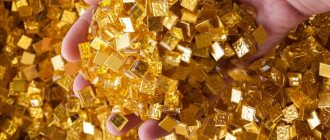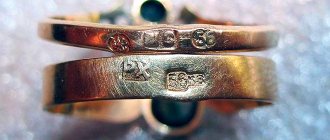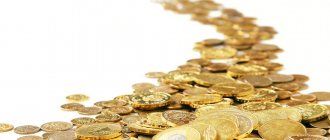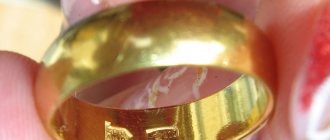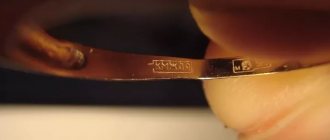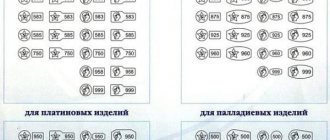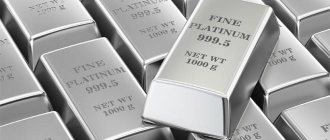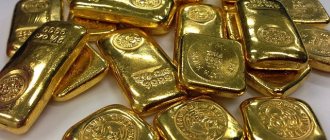Post updated: May 26, 2020
There is no such person who has not seen yellow metal in his entire life. There are several minerals found in nature that are similar in appearance to the yellow metal. But as they say: “all that glitters is not gold.” In order not to confuse the precious metal with other materials, you need to know the density of gold.
Density of noble metal
Molecular structure of gold.
One of the important characteristics of a precious metal is its density. The density of gold is measured in kg m3.
Specific gravity is a very significant characteristic for gold. This is usually not taken into account, since jewelry: rings, earrings, pendants have very little weight. But if you hold a kilogram ingot of real yellow metal in your hands, you can see that it is very heavy. The significant density of gold makes it easier to mine. Thus, washing at sluices ensures a high level of gold recovery from washed rocks.
The density of gold is 19.3 grams per cubic centimeter.
This means that if you take a certain volume of precious metal, it will weigh almost 20 times more than the same volume of plain water. A two-liter plastic bottle of golden sand weighs about 32 kg. From 500 grams of precious metal you can lay out a cube with a side of 18.85 mm.
Table of density of gold of various samples and colors.
The density of the original gold is several units lower than that of the already purified metal and can vary from 18 to 18.5 grams per cubic centimeter.
583 gold is less dense, as this alloy consists of different metals.
At home, you can determine the density of gold yourself. To do this, you need to weigh the precious metal product on ordinary scales, in which the division value must be at least 1 gram. After this, a container with a volume marking must be filled with liquid, in this case water, into which the decoration should be lowered. Care must be taken to ensure that the liquid does not overflow.
After this, we measure how much the volume of liquid has changed after lowering the gold item into the container. Using a special formula, known from school, we calculate density: mass divided by volume.
It must be remembered that a precious metal product is not made of pure gold, so it is necessary to make an adjustment for the density of the alloy sample.
Natural qualities and composition
If we take into account pure gold, which has no impurities, then it is a metal of increased softness, with a characteristic yellow color. Softness can be determined on a ten-point Mohs scale; according to this scale, the hardest is diamond, the hardness of which is measured at 10 points (as you know, diamond can be used to cut glass). If we compare it with gold, then its density on the Mohs scale is 2.5 - 3 points. Speaking about the density of 585 gold, suffice it to say that it can be scratched simply by running a fingernail over it, and if you apply some effort, it can be cut without much difficulty with a knife.
Comparative table of densities of metals mined in nature
Thermal conductivity is high, resistance is low. It should be noted its special malleability, as well as its ductility. It is the ductility that distinguishes gold leaf, the sheets of which are unusually thin; the composition of such a material is truly unique. It is noteworthy that in order to stretch a wire 3 km long, only 1 g of gold is enough. Polishing is also very easy, it should also be noted that it is highly reflective. It is this quality that is very important not only in jewelry, but also in many other industrial fields.
As for gold miners, the most important quality for them is density. It should be noted that only metals belonging to the platinum group have a higher density.
- The density of this metal is 19,300 kg/cubic meter. To make it clear, it must be explained that one of the most expensive metals in the world weighs 19.3 times more than water.
- If a liter bottle is filled with gold sand, its weight will be approximately 16 kg.
- 1 kg can be represented by a cube with a side of 37.7 mm or it can be represented as a sphere whose diameter is 46.2 mm.
How to distinguish real yellow metal from a fake
At the moment, there is a very large percentage of counterfeit gold on both the Russian and foreign markets. There is a huge risk of purchasing gold jewelry containing up to 5% of the precious metal or without it at all. Basic rules when buying gold will help you avoid feeling deceived.
First, you should take a good look at the product. There must be a sample on it. Moreover, it should not consist of crooked numbers or blurry marks. Otherwise, this is the first sign of a counterfeit.
A sample of a unified state hallmark for gold products.
The next sign of a fake is the reverse side of the precious metal jewelry. It must be as well made as the front side, otherwise it is a low-quality product. It is also possible to determine the quality of a product using a characteristic such as gold density, but it is impossible to conduct such an experiment in a store.
There is also a way to determine it, called a strength test. True, it is not always possible to scratch a gold item in front of the seller, so this method cannot be implemented.
Iodine test.
The following chemical methods can serve as good ways to determine the quality of a product. You can drop a little iodine on the yellow metal jewelry. If the speck is dark in color, then we can speak with confidence about the quality of the product being offered. Table vinegar can also help. If, after three minutes spent in it, the precious metal has darkened, then you can safely take the product to a landfill.
Gold chloride can be a great help in determining quality. From the chemistry course, it became known not only the density of gold, but also the fact that it cannot enter into any chemical reactions. Therefore, if after applying gold chloride to a precious metal it begins to deteriorate, then this is a real fake and should belong in the trash.
One of the best ways to protect yourself from purchasing counterfeit goods is to purchase precious metal products in well-known specialized stores.
In this case, there is a high probability of purchasing a truly high-quality product. Even though their price is a little higher than in various shops and markets, the quality is worth it. Otherwise, you can purchase a counterfeit product and very much regret the money saved.
Table of specific gravity of gold depending on the sample
Gold is a soft metal. To improve its technological properties, various alloys are added to the alloy. The sample indicates the proportion of precious metal in thousandths of the alloy. Hallmark 999 is an alloy containing 999 parts of pure gold and 1 part of impurities. Impurities significantly affect the density of the alloy:
To read: Is there gold in Ukraine and where is it mined: list of deposits + maps
| Try | % precious metal | Density g/cm3 |
| 375 | 37,5 | 11,55 |
| 585 | 58,5 | 12,85–13,24 |
| 750 | 75,0 | 15,3–16,6 |
| 999 | 99,9 | 19,3 |
The difference in density for the same alloy sample is due to the different composition of impurities (silver, palladium and copper, which paint products in different colors).
Gemini of gold
There are several metals found in nature that have the same density as gold. These are uranium, which is radioactive, and tungsten. It is cheaper than the yellow metal, but the density of tungsten and gold is almost the same, the difference is three tenths. What distinguishes tungsten from gold is that it has a different color and is much harder than the yellow metal. Pure gold is very soft and can be easily scratched with a fingernail.
A fake gold bar filled with tungsten on the inside.
The fact that the density of elements such as tungsten and gold is the same is very attractive to counterfeiters. They replace gold bars with tungsten of similar density and weight, and cover the top with a thin layer of precious metal. At the same time, the high cost of the yellow metal makes tungsten more popular among young people. Tungsten products are much cheaper and more scratch resistant.
What is specific gravity
A conventional value showing how much a cube with sides of 1 meter (centimeter) will weigh is called specific gravity (volume weight). It is measured in kilograms per cubic meter (grams per cubic centimeter). At the Earth's poles, the force of gravity is greater, so the density of the substance (that is, the ratio of the mass of the metal to the volume) is taken as the basis for measurements, which differs by the value of the acceleration of gravity, depending on the location of measurement (from 9.780 m/s2 at the equator to 9.832 m/s2 at poles).
Specific gravity is confused with density; their numerical values in different measurement systems are the same. In my case, when the difference in the acceleration of free fall can be neglected, such a loose comparison is acceptable.
Lead Density
The purer the gold, the less hard it is, so in the past the yellow metal was bitten to test. This method is unreliable. The jewelry can be made of lead, covered with a very thin layer of gold. Lead also has a soft structure. You can try to scratch the jewelry from the wrong side, and underneath a very thin layer of precious metal you may find base metal.
The density of the element of the periodic table - lead and its brother - gold is different. The density of lead is much less than gold and is 11.34 grams per cubic centimeter. Thus, if we take the yellow metal and lead of the same volume, then the mass of gold will be much greater than that of lead.
White gold is an alloy of yellow precious metal with platinum or other metals that give it a white, or rather matte silver, color. There is an opinion in everyday life that “white gold” is one of the names for platinum, but this is not so. This type of gold costs a little more than usual. In appearance, the white metal is similar to silver, which is much cheaper. The density of such elements of the periodic table as gold and silver is different. How to distinguish white gold from silver? These precious metals have different densities.
Silver is the least dense material of all those discussed in the article.
The density of gold is greater than that of silver. Its density is 10.49 grams per cubic centimeter. Silver is much softer than white metal. Therefore, if you run a silver item across a white sheet, a mark will remain. If you do the same with white precious metal, there will be no trace.
Level of international reserves
International reserves of the world's countries in 2006
| States with the largest international reserves. | $1953 (March 2009) | |
| 2 | Japan | $1042.34 (August 2009) |
| — | Eurozone | $531 (February 2009) |
| 3 | Russia | $413 (July 2009) |
| 4 | Republic of China | $305 (April 2009) |
| 5 | India | $256 (May 2009) |
| 6 | The Republic of Korea | $212 (April 2009) |
| 7 | Brazil | $203 (March 2009) |
| 8 | Hong Kong | $186 (March 2009) |
| 9 | Singapore | $166 (March 2009) |
| 10 | Germany | $144 (February 2009) |
These ten countries contain more than 50 percent of the world's total international reserves.
Basic properties
Important properties of the noble metal are various physical and mechanical aspects:
- In itself it is quite a heavy metal. The density of gold is also high and equal to 19.32 g/cm3. The specific gravity of a metal is a unit of calculation that indicates its density. Specific gravity is important when producing an alloy. The highest quality is a mixture of metals with a slight difference in specific gravity.
- The color of the alloy can indicate the impurities present in it. The shade of red is a sign of the presence of copper in it. Platinum, silver or tin can change the color from yellow to white. A bluish-white tint indicates the presence of lead.
- The melting point of gold is 1095 degrees Celsius. Only in this case does it melt and become liquid.
Receipt methods
Basically, the noble metal is extracted from ore and alluvial deposits using various methods:
- Sifting is considered the oldest method of extraction. This method is based on the large difference in the specific gravity of the rocks. The disadvantage is a large loss of metal.
- Amalmagation has also been known for a long time. In this technique, the gold ore is first crushed. Then you need to add a solution of sodium cyanide and precipitate with zinc.
- Gold ore is a source of precious metal. In this case, it is extracted using the refining method. To do this, the ore is first roasted. Zinc is then added and the metal is separated using sulfuric acid.
The influence of various factors on the price
Many are concerned about the question of how much a gram costs today. The cost of 999 gold depends on many factors:
- One of the main reasons influencing the cost of a gram of 999 gold is the mining volume. An important rule of economics “demand creates supply” applies here. 999 gold is a rare material and therefore expensive. If you increase the volume of production, its cost and profits of enterprises will drop significantly. Therefore, extracting precious material in large quantities is not economically profitable for mining companies.
- How much 1 gram of 999 gold costs depends on the demand for it. This material is mainly used in the manufacture of jewelry and high-tech products. Companies purchase precious material for commerce, and the volume of purchases is easy to predict. The higher the demand, the higher the price of 999 gold.
- The cost of 1 gram of gold also depends on the exchange rate stability of the US dollar on the London Currency Exchange. The principle of inverse relationship comes into play here: if the exchange rate rises, the price of 999 gold falls, and vice versa. This is due to the fact that, fearing losing profits when the currency rate falls, investors begin to invest money in precious metals. As demand grows, prices rise.
On the London Stock Exchange, the exchange rate is displayed in troy ounces of gold. The question immediately arises, how many grams are in an ounce? One troy ounce contains 31.1 g of metal.
- The price of 999 gold is also influenced by the policy of the Central Bank. More than 60% of the reserves of large states are precisely 999 gold. If they begin to accumulate or, conversely, distribute their reserves, the price of 1 gram changes.
- As for investing in precious metals for an ordinary buyer, it is impossible to predict the gold rate here. This is due to the fact that there is practically no freely available information about fluctuations on the currency exchange, and what appears is already taken into account by the foreign exchange market, and there is no point in relying on it. Therefore, you can buy or sell precious metal based on online data that is available around the clock. The quote shows any fluctuations in the currency and precious materials market.
The cost per gram has varied over the years. For comparison, you can look at data for the last five years.
| Year | Cost of 1 gram in rubles |
| 2012 | 1666,34 |
| 2013 | 1435,45 |
| 2014 | 1565,37 |
| 2015 | 2275,44 |
| 2016 | 2682,96 |
In 2021, the cost of a gram of 999 gold is about 2300.
Dependence of price on form
On the Russian gold and foreign exchange market, the cost of gold 999 depends on the form of its release. It can be bought and sold as bullion (the weight of the bullion is also important here), commemorative coins, metal deposits in a bank:
- the retail price of a gold bar is higher than the market price. This is due to the fact that the price includes VAT, which is 18%, and the bank’s commission for the sale of the bullion. To understand how much such an investment costs, you need to know how much a gold bar weighs. In Russia, a 999 gold bar is produced according to GOST, which implies a gold weight of no more than 1 kg. Then the question arises, how much is a kilogram of gold worth? It is not difficult to calculate the approximate cost, based on the price of 05 or 10 grams of precious metal. How much 10 g costs can be traced on the foreign exchange market. It is 22,500 rubles. From this we conclude that for a kilogram of 999 fine gold you will have to pay about 2,000,000 rubles;
- If we talk about the convenience and reliability of investing, then the best option is impersonal metal bank accounts. In this case, the buyer of the precious metal does not need to spend additional funds on the protection and transportation of the metal. In addition, a bank client can sell gold savings at any time. This investment option is also beneficial because its purchase is not subject to VAT;
- An equally profitable investment is buying gold coins. Here the price depends on many factors. As a rule, the cost of commemorative coins is quite high, since it includes the work of production, the exclusivity of the issue, and the number of coins. In addition, other precious metals and stones may be used in production. And many exclusive coins are true masterpieces for collectors. In this case, even after decades, the value of the coins will be high, since it depends not on the price per gram, but on the collection value.
But such a treasure must be handled with extreme care, because when sold, the value is affected not only by the exclusivity of the circulation, but also by the appearance of the coin. Scratches and chips are taken into account here. And if the coin doesn’t look right, the bank may not accept it and refuse to redeem it. In this case, it can only be sold to jewelers at the price of scrap.
The noble metal was and is an excellent means of investment. Its value is not invested and has approximately tripled over the past 10 years. But fluctuations in the foreign exchange market continue to affect the price of one gram of gold metal.

